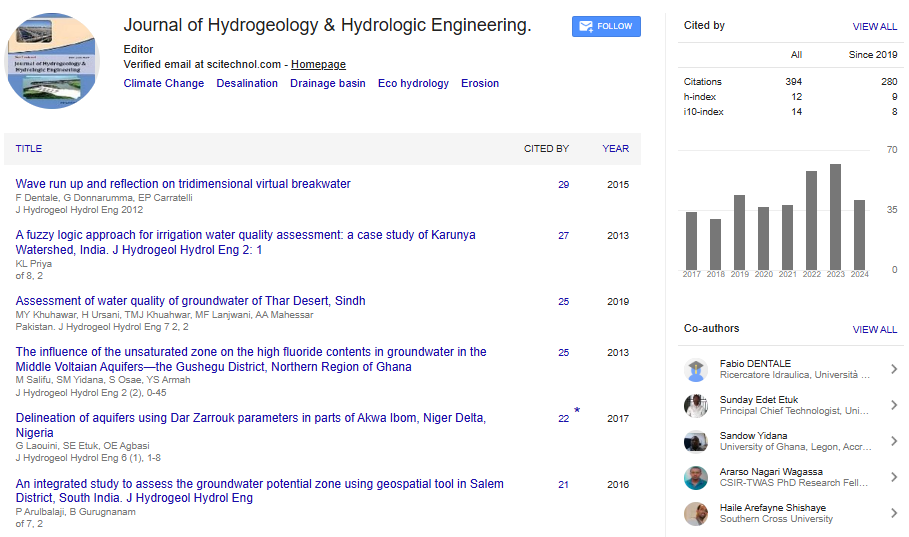Perspective, J Hydrogeol Hydrol Eng Vol: 13 Issue: 4
The Importance and Dynamics of Surface Water in Hydrologic Systems
Santiago Lopez*
1Department of Environmental Science, University Putra Malaysia, Selangor, Malaysia
*Corresponding Author: Santiago Lopez,
Department of Environmental Science
University Putra Malaysia, Selangor, Malaysia
E-mail: lopezs39@gmail.com
Received date: 29 July, 2024, Manuscript No. JHHE-24-149244;
Editor assigned date: 31 July, 2024, PreQC No. JHHE-24-149244 (PQ);
Reviewed date: 14 August, 2024, QC No. JHHE-24-149244;
Revised date: 21 August, 2024, Manuscript No. JHHE-24-149244 (R);
Published date: 29 August, 2024, DOI: 10.4172/2325-9647.1000332
Citation: Lopez S (2024) The Importance and Dynamics of Surface Water in Hydrologic Systems. J Hydrogeol Hydrol Eng 13:4.
Description
Surface water is an essential component of the Earth's hydrologic system. It includes all water bodies visible on the Earth's surface, such as rivers, lakes, reservoirs, streams and ponds. This natural resource is essential for sustaining ecosystems, supporting human life, agriculture and industrial activities. Its management, quality and availability are precarious factors that influence both environmental stability and societal development.
Surface water can be classified into two broad categories: Perennial and ephemeral water bodies. Perennial water sources, like major rivers and lakes, flow continuously throughout the year, while ephemeral sources only appear after rainfall, such as temporary ponds or seasonal streams. These water bodies are directly affected by climatic factors, geological formations and human activities.
One of the primary forms of surface water, rivers play an essential role in transporting water from one area to another, recharging aquifers and supporting diverse ecosystems. Lakes can be natural or manmade, with reservoirs primarily designed for water storage, flood control, or hydropower generation.
Transitional areas between land and water, wetlands act as buffers for floods, filters for pollution and habitats for many species. Smaller water bodies, such as ponds and streams, serve as precarious ecosystems and are often used for agricultural and recreational purposes.
Surface water plays a key role in the hydrologic cycle, which describes the continuous movement of water on, above and below the surface of the Earth. This cycle involves evaporation, condensation, precipitation and runoff. Surface water bodies act as collectors of rainfall and through runoff, they transport water from the land to the oceans.
In the context of hydrologic engineering, understanding how surface water interacts with other components of the hydrologic cycle is precarious for flood control, urban planning, water resource management and predicting the effects of climate change on water availability.
Precipitation patterns and evaporation rates influence the volume and distribution of surface water. In regions with high rainfall, rivers and lakes maintain a steady flow, while arid areas face challenges of scarcity and variability. The landscape affects the flow and accumulation of surface water. Mountainous regions with steep slopes allow rapid runoff, while flat terrains, like plains, encourage water pooling, forming lakes or wetlands.
Dams, irrigation, deforestation and urbanization alter the natural distribution of surface water. While dams are constructed for water storage and electricity, they can disrupt natural ecosystems and downstream water flow. Similarly, urbanization can increase surface runoff and reduce groundwater recharge. Surface water is highly vulnerable to contamination from agricultural runoff, industrial waste and domestic sewage. Pollutants can degrade water quality, harm aquatic life and make water unsuitable for human consumption.
Surface water bodies are precarious habitats for a wide range of species. Rivers and lakes support fish populations, while wetlands provide habitats for amphibians, birds and plants. These ecosystems are interconnected, with surface water acting as the lifeblood that supports biodiversity.
Additionally, surface water is essential for agricultural and industrial activities. In agriculture, irrigation systems depend heavily on rivers, lakes and reservoirs to supply water for crops. In industry, surface water is used for cooling, processing and manufacturing, making it indispensable for economic development.
Sustainable management of surface water resources is becoming increasingly precarious due to growing demand, climate change and pollution. Integrated Water Resource Management (IWRM) approaches consider the social, economic and environmental dimensions of water use to ensure equitable distribution and long-term availability.
Conclusion
Surface water remains a vital resource for human survival, ecosystem health and economic activities. Understanding its dynamics within the hydrologic system allows for better management and protection of this valuable resource, ensuring its availability for future generations. Effective policies, sustainable practices and community involvement are essential to preserve surface water's ecological and societal functions.
 Spanish
Spanish  Chinese
Chinese  Russian
Russian  German
German  French
French  Japanese
Japanese  Portuguese
Portuguese  Hindi
Hindi 
